- Top Employee Onboarding Software
- Why Use Employee Onboarding Software?
- Key Features of Effective Onboarding Software
- How To Choose The Right Onboarding Software?
- Which is the Best Onboarding Software?
- Frequently Asked Questions (FAQs)
- What Is Upskill And Reskill?
- Difference Between Reskilling And Upskilling
- Upskilling for Workplace Advancement
- Reskilling for Career Transformation
- Crafting Successful Upskill and Reskill Strategies
- Upskill And Reskill Strategizing: Things to Keep in Mind
- Measuring the Impact of Skill Development Initiatives
- Frequently Asked Questions
- What’s a Skill Gap?
- Employee Skill Gap Analysis: Why Do We Need It?
- How To Conduct Employee Skill Gap Analysis?
- Addressing Skill Gaps Through Training and Hiring
- Utilizing Skills Gap Analysis for Strategic Planning
- Leveraging Employee Skill Gap Analysis: Things To Keep In Mind
- Frequently Asked Questions
- Transformative Role of AI in Talent Acquisition
- Impact of AI on Business Recruiting
- Overcoming Challenges in AI-Driven Talent Acquisition
- Starting with AI in Talent Acquisition
- Future Landscape of AI in Talent Acquisition
- Frequently Asked Questions
- HR In The Hot Seat - Challenges With Evolving Workforce
- Mastering Effective HR Management: Tips For Overcoming Challenges
- Summing Up
- The Future of HR: Key Trends for 2024
- Skill-Based Hiring
- Prioritizing Employee Experience, Engagement & Well-being
- AI-Empowered Workforce Evolution and Its Impact
- Taking Diversity, Equity, and Inclusion Beyond Mandates
- Hybrid and Remote Work
- Embracing the Gig Economy and Blended Workforce
- Transparent HR Practices
- Climate Change Adaptation in HR Practices
- Leveraging HR Analytics for Data-Driven Decisions
- Continuous Learning & Development to Improve Productivity
- The Office Buzz in 2024
- Bottom Line - HR Operating Model Needs A Shift
- Importance and Impact of Recognizing Employee Birthdays
- Professional Birthday Wishes for Employees (All Experience Levels)
- Personalized Birthday Wishes for Employees in Different Roles
- Fun Birthday Wishes for Employees (with Templates)
- Birthday Wishes for Remote Employees
- Heartfelt Birthday Wishes for Employees
- Belated Birthday Wishes for Employees
- Simple & Sweet Birthday Wishes for Employees
- Celebrating Employee Birthdays: Ideas and Traditions
- Tips and Ideas for Sending Birthday Wishes to Employees
- Closing Thoughts
- Frequently Asked Questions
- What Is An Employee Referral?
- Benefits of Implementing Employee Referral Programs
- Setting Up an Effective Employee Referral Program
- Employee Referral Email
- Employee Referral Scheme
- Overcoming Challenges of Employee Referrals
- Companies with Best Employee Referral Programs
- Employee Referral Programs: Best Practices
- Closing Thoughts
- Frequently Asked Questions (FAQs)
- Importance of Team Building Activities
- Types of Team Building Activities
- Outdoor Team Building Activities for Employees
- Indoor Team Building Activities for Employees
- Easy Team Building Activities for Remote Employees
- Team Building Activities For New Employees (Icebreakers)
- Fun Team Building Activities for Different Goals
- To Boost Communication and Collaboration
- To Reduce Stress Levels and Promote Well-being
- Aligning Team Purpose and Values with Strategic Activities
- Final Remarks
- Frequently Asked Questions
- Importance of Employee Appreciation Quotes
- Work Appreciation Quotes for Employees
- Employee Appreciation Quotes for Hard Work Recognition
- Employee Appreciation Quotes for Teamwork and Collaboration
- Appreciation Quotes for Celebrating Employee Anniversaries and Milestones
- Employee Appreciation Quotes for Strong Work Ethics
- Employee Appreciation Quotes for Project & Goal Completion
- Employee Appreciation Quotes for Quality of Work
- Employee Appreciation Quotes for Creativity and Innovation
- Appreciation Quotes for Managers
- Peer-to-Peer Employee Appreciation Quotes
- Appreciation Quotes for Employees Leaving the Company
- Employee Appreciation Quotes for Thoughtful Gestures
- Funny Employee Appreciation Quotes
- Short Employee Appreciation Quotes
- Employee Appreciation Quotes for Different Roles
- Employee Appreciation Quotes for Senior Leadership
- Creative Ways to Use Employee Appreciation Quotes
- Summary
- Frequently Asked Questions (FAQs)
- What is Employee Satisfaction?
- Importance of Employee Satisfaction
- Objectives of Employee Satisfaction
- Employee Satisfaction vs. Employee Engagement
- Key Reasons for Employee Dissatisfaction
- Strategies for Improving Employee Satisfaction
- Ways to Measure Employee Satisfaction
- Best Practices for High Employee Satisfaction
- Final Remarks
- Frequently Asked Questions (FAQs)
- How to Craft Effective Employee Appraisal Comments
- Key Areas to Focus in Performance Review
- Comments On Hard Work & Dedication
- Assessing Interpersonal Skills
- Evaluating the Ability to Collaborate & Work in Teams
- Gauging Punctuality
- Commenting on Communication Style
- Reviewing Time Management and Productivity
- Leadership in Performance Appraisals
- Assessing Creativity & Innovation
- Evaluating Problem-Solving Abilities
- Recognizing Flexibility and Dependability in Reviews
- Employee Appraisal Comments for Different Roles
- Summary
- Frequently Asked Questions (FAQs)
- Employee Grievance Meaning
- Importance of Employee Grievance Process
- Types of Workplace Grievances
- Reasons for Employee Grievances
- Employee Grievance Procedure
- Steps in the Employee Grievance Handling Process
- Employee Grievance Form Example
- Final Remarks
- Frequently Asked Questions (FAQs)
- What is Company Culture?
- Importance of Company Culture
- Types of Company Culture
- Factors Contributing to Organizational Culture
- Assessing & Developing Corporate Culture
- Company Culture - It’s not just Perks or Feels
- Good Company Culture Examples
- Developing Company Culture: Best Practices
- Closing Thoughts
- Frequently Asked Questions (FAQs)
- What is Employee Empowerment?
- Benefits of Empowering Employees
- Employee Empowerment vs. Micromanagement
- Strategies for Effective Employee Empowerment
- Role of Managers in Fostering Empowerment
- Organizational Structure Supporting Empowerment
- Overcoming Barriers to Employee Empowerment
- Frequently Asked Questions (FAQs)
- What is Employer Branding?
- Importance of Employer Branding Strategy
- How to Build an Employer Branding Strategy?
- Strategies for Building a Strong Employer Brand
- How to Measure and Boost Your Employer Branding Success?
- Examples of Strong Employer Brand Strategy
- Best Practices for an Effective Employer Branding Strategy
- Closing Thoughts
- Frequently Asked Questions (FAQs)
- What are Employee Wellness Programs?
- Importance of Employee Wellness Programs
- Examples of Employee Wellness Programs
- Real-Life Examples of Corporate Wellness Programs
- Strategies for Encouraging Participation
- Supporting Diverse Employee Needs
- Creating Comprehensive Wellness Programs
- Measuring the Impact on Business and Employees
- Closing Thoughts
- Frequently Asked Questions (FAQs)
- What is Talent Management?
- Developing a Winning Talent Management Strategy
- Models and Frameworks
- Tips for Framing Effective Talent Management Strategy
- Looking Ahead: Recent Trends in Talent Management
- Frequently Asked Questions
- Role of AI in HR: Addressing Common Challenges
- Artificial Intelligence in HR Processes
- AI Tools for HR Functions
- How to Adopt AI in HR?
- Addressing Challenges of AI in HR
- Ethical and Responsible AI Use
- The Future of AI in HR
- Closing Thoughts
- Frequently Asked Questions
- What is Performance Management?
- Elements of Effective Performance Management
- Performance Management Cycle
- Differentiating Performance Management
- Benefits of Performance Management With Examples
- Challenges faced in Performance Management and their Solutions
- Future Trends in Performance Management
- Frequently Asked Questions
- Changing Role of HRM
- Changing Role Of HR Manager
- Technology and the Changing Role of HRM
- The Rise of AI and Machine Learning in HR
- Mobile Technology's Impact on HR Practices
- The Significance of People Analytics in HR
- Navigating the Future of HR Technology
- Final Remarks
- Frequently Asked Questions
- Compensation Management Meaning
- Compensation Types
- Breaking Down The Compensation Management Process
- HR Software for Compensation Management
- Current Trends in Compensation Management
- Frequently Asked Questions
- Defining Flexible Work Arrangements
- Flexible Working: Advantages for Businesses
- Challenges of Flexible Work Arrangements
- Crafting Flexible Working Practices
- Types Of Flexible Work Arrangements
- Comparing Flexible Work Arrangements
- Real-Life Examples of Flexible Work Arrangements
- Final Remarks
- Frequently Asked Questions
- Conflict Resolution Meaning
- Conflict Origins
- Tried & Tested Conflict Resolution Strategies
- Methods of Conflict Management at Workplaces
- Conflict Resolution Strategies: Top Management Tips
- Summary
- Frequently Asked Questions
- Career Development Meaning
- Career Development Plan for Employees
- Career Development in HRM: Growth Ideas For Employees
- Issues in Career Development and Their Solutions
- Closing Thoughts
- Frequently Asked Questions
- Understanding Compensation
- Exploring Benefits
- Difference between Compensation and Benefits
- Compensation & Benefits Structure
- Final Remarks
- Frequently Asked Questions
- Defining Recruitment in HR Practices
- Exploring Talent Acquisition in HR
- Understanding Talent Acquisition vs Recruitment
- When to Recruit or Acquire Talent
- Talent Acquisition vs Recruitment: Responsibilities
- From Recruitment To Talent Acquisition
- Closing Thoughts
- Frequently Asked Questions
- Work Culture Meaning
- Types of Work Cultures
- Components of Culture
- Best Work Culture Examples Set By Top Companies
- Creating a Positive Work Culture
- Closing Thoughts
- Frequently Asked Questions
- Defining Learning vs Development
- Importance of Learning and Development
- L&D Activities for Employees
- Choosing the Right L&D Activities
- Crafting an Effective L&D Strategies
- Aligning L&D Strategy with Business Goals
- Designing Engaging Learning Journeys
- Learning and Development Process: KPIs
- ROI in Learning and Development
- Emerging Trends in L&D
- Closing Thoughts
- Frequently Asked Questions
- What Is Leadership Development?
- Key Skills for Leaders
- How To Develop Leadership Skills in Organizations?
- What Is A Leadership Development Program?
- How To Develop A Leadership Development Program?
- Example of A Leadership Development Plan
- Benefits of Leadership Development Training
- Frequently Asked Questions
- Defining Diversity Training
- Importance of Diversity Training
- What are the Types of Diversity?
- Types of Diversity Training Methods
- Diversity Training Activities
- Choosing A Diversity Training Program
- How to Implement Diversity Initiatives
- Best Diversity Training Programs (Real-Life Examples)
- Improving the Effectiveness of Diversity Training
- Tracking and Evaluating the Results of DE&I Training Efforts
- Essential Elements for Successful Diversity Training
- Closing Thoughts
- Frequently Asked Questions
- Defining Occupational Health & Safety
- Evolution of Workplace Health and Safety
- Identifying Common Workplace Hazards
- Global Impact on Occupational Health & Safety
- Managing Employee Health and Safety Risks
- Occupational Health and Safety Problems
- Future of Occupational Health and Safety
- Frequently Asked Questions
- Employee Orientation Defined
- Employee Onboarding Explained
- Orientation and Onboarding: Understanding the Difference
- Importance of Orientation and Onboarding
- Crafting Comprehensive Integration Strategies
- Quick Tips for Orientation and Onboarding
- Frequently Asked Questions
- What is HR Metrics?
- Importance of HR Metrics
- HR Metrics Examples in Recruitment
- HR Metrics Examples in Employee Retention
- HR Metrics Examples in Revenue
- Other Common HR Metrics
- Soft HR Metrics Example
- HR Metrics Formula
- Utilizing HR Metrics Effectively
- Future of HR Metrics
- Summary
- Frequently Asked Questions
- Defining Decision Making Process
- Key Concepts In Decision Making
- Decision Making & Problem Solving
- Tips For Improving Decision Making Skills
- Selected Practice Questions & Answers
- Conclusion
- Frequently Asked Questions (FAQs)
- A case(s) of miscommunication
- The devil is in the (resume) details
- One for the complaints!
- What is an Exit Interview?
- Benefits of Exit Interviews to an Organization
- How to Conduct Exit Interviews?
- Exit Interview: Sample Questions to Ask
- Overcoming Challenges of Exit Interviews
- Exit Interviews: Best Practices
- Closing Thoughts
- Frequently Asked Questions
- Technology in the Workplace
- Benefits of Tech Integration
- Technology in the Workplace: Key Functions
- How Technology Normalized Remote Work
- Workplace Technology: Top Tools and Software
- Steps for Effective Technology Implementation
- Overcoming Tech Implementation Challenges
- Ethical Considerations in Tech Use
- Keeping Pace with Tech Trends
- Closing Thoughts
- Frequently Asked Questions
- What is Ethical Leadership?
- Principles of Ethical Leadership
- Difference between Ethics and Integrity
- Importance of Ethical Leadership
- Ethical Leadership in Practice
- Overcoming Challenges
- Frequently Asked Questions
- Embracing Change Management
- Mastering People Analytics
- Enhancing Stakeholder Relationships
- Navigating Diversity, Equity & Inclusion
- Upholding Ethics and Data Privacy
- Developing Critical Thinking
- Advancing Negotiation Techniques
- Fostering Inter-departmental Collaboration
- Building Resilience in HR
- Frequently Asked Questions
- What is Mental Health?
- Benefits of a Mentally Healthy Workforce
- Prioritising Mental Health: Creating a Culture of Support
- Final Remarks
- Frequently Asked Questions
- Gen Z vs Millennials - What is the difference?
- Retain and Engage Gen Z Employees: Need and Strategies
- Strategies to Retain and Engage Gen Z Employees
- Rethinking Requirements
- Final Remarks
- Frequently Asked Questions
- Understanding Millennial Leadership Needs
- Key Leadership Skills for Millennials
- How To Develop Millennial Into Leaders
- Additional Strategies to Develop Leaders
- Learning Preferences of Millennials
- Benefits of Investing in Millennial Leaders
- Closing Thoughts
- Frequently Asked Questions
- Understanding Fluff
- Examples of Interview Fluff
- Identifying Interview Fluff
- Addressing Interview Fluff
- Seeing Through the Fluff
- Frequently Asked Questions
- What is the Gender Pay Gap?
- Is the Gender Pay Gap Real?
- Factors Affecting the Gender Pay Gap
- How Age Impacts Women’s Earnings
- The ‘Motherhood Penalty’
- Education's Role in Wage Differences
- Racial and Ethnic Disparities in Pay
- Closing the Gender Gap
- Frequently Asked Questions
- Top Weirdest Late-To-The-Office Excuses
- The Fine Art of Balancing Wit and Wisdom in HR
- Understanding Social Media Recruiting
- Crafting Your Social Media Recruitment Strategy
- Implementing Your Strategy Effectively
- Popular Platforms for Recruitment
- Navigating the Downsides of Social Media Recruiting
- Measuring Success and Adjusting Strategy
- Summary
- Frequently Asked Questions
- Who Is A High Potential (HIPO) Employee?
- Characteristics of A High Potential (HIPO) Employee
- High Potential Employee Identification
- Grooming High Potential Employees
- Why High Potential Employees Leave
- How Do You Retain High Potential Employees?
- High Potential Employee Development: Best Practices
- Closing Thoughts
- Frequently Asked Questions
- What is Digital Fluency?
- Why Digital Fluency Matters?
- Difference between Digital Literacy and Digital Fluency
- Key Components of Digital Fluency
- Achieving Digital Fluency
- Overcoming Challenges
- Future of Workforce Digital Fluency
- Frequently Asked Questions
- What is Loud Quitting?
- Pros and Cons of Loud Quitting
- Reasons Behind the Trend
- Analyzing the Impact
- How HR Can Navigate the Loud Quitting Uproar
- Preventive Strategies
- Closing Thoughts
- Frequently Asked Questions
- Defining Emotional Intelligence in HR
- Why Emotional Intelligence Matters for HR Leaders
- How To Build Emotional Intelligence in HR
- Integrating EQ into HR Practices
- Impact of EQ on Company Culture
- Emotional Intelligence in HR: Major Challenges
- Final Remarks
- Frequently Asked Questions
- Understanding Internal Job Posting
- Internal Job Posting: Pros and Cons
- The Internal Job Posting Process
- Writing Effective Ads for Internal Job Posting
- Strategies for Success of Internal Job Posting
- Summary
- Frequently Asked Questions
- Understanding Workplace Bias
- Common Types of Bias in HR
- Closing Thoughts
- Frequently Asked Questions
- What is a Dry Promotion?
- Dry Promotion: Pros and Cons for Companies
- Impact of Dry Promotion on Employee Retention
- Preventing Talent Loss After Dry Promotions
- Closing Thoughts
- Frequently Asked Questions
- What Is A Stay Interview?
- Importance Of Stay Interviews
- Benefits And Challenges Of Stay Interviews
- Planning And Conducting Stay Interviews
- Stay Interviews: 20 Sample Questions To Ask
- Best Practices For Effective Stay Interviews
- Summary
- Frequently Asked Questions
- Who Is A Boomerang Employee?
- Reasons For Returning
- Benefits Of Hiring Boomerang Employees
- Challenges Of Rehiring
- Interviewing Boomerang Candidates: Sample Questions
- Enhancing The Hiring Process
- Making Informed Decisions
- Final Remarks
- Frequently Asked Questions
- Talent Pipeline Meaning
- Significance of Talent Pipelines
- Advantages of a Talent Pipeline
- Building a Talent Pipeline
- Maintaining a Talent Pipeline
- Attracting Top Talent
- Implementing the Strategy
- Frequently Asked Questions
- What is Micromanagement?
- Recognizing Micromanagement
- Leadership versus Micromanagement
- Keeping Micromanagement in Check
- Beyond Micromanagement
- Summing Up
- Frequently Asked Questions
- Recognizing Signs Of A Bad Hire
- Understanding The Impact On Teams
- Dealing With A Bad Hire
- Preventing Future Bad Hires
- Closing Thoughts
- Frequently Asked Questions
- Defining Neurodiversity
- Importance of Neurodiversity in the Workplace
- Moving Towards Inclusive Environments
- Final Remarks
- Frequently Asked Questions
- Understanding the Generation Gap
- Multigenerational Workforce: Debunking Stereotypes
- Strategies for Bridging the Gap
- Benefits of a Multigenerational Workforce
- Final Remarks
- Frequently Asked Questions
- Defining Productivity Theatre: All Show, No Go
- 5 Key Drivers of Fake Productivity
- Solutions to Combat Productivity Theatre
- Summary
- Frequently Asked Questions
- Defining Grumpy Staying
- Why do Grumpy Stayers not Leave?
- Recognizing the Signs
- Exploring the Causes
- Understanding the Impact
- Addressing the Issue
- Taking Action: Addressing Grumpiness with Empathy
- After the Conversation
- When Grumpy Staying Continues
- Closing Thoughts
- Frequently Asked Questions
- The Rationale Behind Office Peacocking
- Impact on Company Culture
- Impact on Employees
- Case Studies: Examples of Office Peacocking
- The Downside: Potential Pitfalls of Office Peacocking
- Practical Tips for Implementing Office Peacocking
- Frequently Asked Questions
- 13 Common Mistakes Young Managers Make
- Strategies To Avoid Mistakes (Individual Growth)
- How Young Managers Can Boost Teamwork
- Learning From Errors
- Summary
- Frequently Asked Questions
- Understanding Great Regret - What causes the shift shock?
- Impact of Great Regret
- How can HR help make the situation better?
- Closing Thoughts
- Frequently Asked Questions
- Understanding the HR Budget
- Key Components of an HR Budget
- Preparing an HR Budget Step-by-Step
- Importance of HR Budgeting in Management
- Final Remarks
- Frequently Asked Questions
- What are Pre-Employment Assessments?
- Importance of Pre-Employment Testing
- Types of Pre-Employment Assessments
- 15 Tips for Creating Effective Pre-Employment Assessments
- Closing Thoughts
- Frequently Asked Questions
- Exploring the Productivity Paradox
- Understanding the Impact of Solow Paradox
- Productivity Paradox: Why it Matters for Recruiters & HRs
- Identifying Causes and Challenges
- Strategies for Enhancing Productivity
- AI & the Modern-Day Productivity Paradox
- Beyond Technology: Building a Productive Workforce
- Summary
- Frequently Asked Questions
- Understanding the Great Reshuffle 2.0
- Preparing Leaders for the Change
- HR’s Role in Handling Great Reshuffling 2.0
- The Way Ahead
- Frequently Asked Questions
- Definition Of Managerial Grid
- Managerial Grid Theory Explained
- Application Of Managerial Grid
- Criticisms And Limitations
- Evolution And Contemporary Perspectives
- Integrating Managerial Grid With Other Models
- Practical Steps For Implementing Managerial Grid
- Conclusion
- Frequently Asked Questions
- Understanding Skills Taxonomy
- Why do we Need Skills Taxonomy?
- Benefits of Skills Taxonomy
- Components of Skills Taxonomy
- Building a Skills Taxonomy: A Step-by-Step Guide
- Skill Taxonomies vs Intelligence Tools
- Closing Thoughts
- Frequently Asked Questions
- Definition Of Team Building
- Stages Of Team Development
- Top 10 Strategies For Effective Team Building
- Team Building Activities
- Best Practices For Effective Team Building
- Setting Team Building Objectives
- Challenges In Team Building
- Conclusion
- Frequently Asked Questions (FAQs)
- Defining Job Shadowing
- Unpacking the Benefits
- Setting Up the Experience
- Job Shadowing vs Internship
- Dos and Don'ts for HR Professionals
- Closing Thoughts
- Frequently Asked Questions
- Employee Journey Mapping: Meaning & Importance
- Stages of the Employee Journey
- Steps for Effective Mapping
- Employee Journey Map: Where does it begin?
- Employee Journey Map: Template
- Best Practices & Tips
- Summary
- Frequently Asked Questions
- Why are Performance Appraisals needed?
- Evolution of Performance Management
- Modern Performance Practices
- Benefits of Modern Performance Appraisals
- The Future
- Frequently Asked Questions
- Is Experience the Sole Indicator of Success?
- Why Hire Inexperienced Talent?: Key Advantages
- Skills to Look For in Inexperienced Talent
- Challenges and Considerations in Hiring Inexperienced Talent
- Final Remarks
- Frequently Asked Questions
- What is a Company Retreat?
- Company Retreat Ideas: Team-Building & Exploration
- Relaxation and Celebration
- Planning Your Retreat: Things to Keep in Mind
- Closing Thoughts
- Frequently Asked Questions
- Understanding HR Forecasting
- HR Forecasting Key Concepts
- Steps for Implementing HR Forecasting
- Common HR Forecasting Methods
- Closing Thoughts
- Frequently Asked Questions
- What is ESG?
- HR and ESG - Why Care?
- ESG in HR Strategy
- Challenges for HR
- Future of ESG in HR
- Frequently Asked Questions
- Defining the Great Betrayal
- Reasons for Its Spread
- Impact on Workers
- Impact on Corporations
- Rebuilding Trust & Valuing Employees
- Closing Thoughts
- Frequently Asked Questions
- Importance of Clear Expectations
- Setting Expectations Early
- Communicating Expectations Effectively
- Differentiating Expectations
- Reviewing and Adjusting Expectations
- Summing Up
- Frequently Asked Questions
- Understanding KRA Frameworks And Models
- KRAs vs KPAs and KPIs
- Monitoring and Tracking KRAs
- KRAs in Various Roles
- Impact of KRA Frameworks and Models on Organizational Success
- Frequently Asked Questions
- Where: The Place of Work
- When: The Time of Work
- How Much Work: Alternate Employment Models
- Who Does the Work: Intelligence
- Designing Organizations with the Four Dimensions of Work
- Summing Up
- Simplifying Processes: The Foundation of Efficiency
- Reducing Unnecessary Meetings: Reclaiming Valuable Time
- Building Strong Accountabilities: Ensuring Responsibility
- Role of HR in Addressing Inefficiencies
- Continuous Improvement: A Commitment to Excellence
- Leadership's Role in Driving Efficiency
- Conclusion: A Holistic Approach to Efficiency
- Understanding Financial Freedom
- Benefits of Empowering Employees Financially
- Empowering Employees Through Financial Literacy
- Financial Topics That Need Attention Based On Career Stage
- Summing Up
- Frequently Asked Questions
- Defining Employee Voice
- Benefits of Amplifying Employee Voice
- Strategies and Tools
- Encouraging Participation
- Closing Thoughts
- Frequently Asked Questions
- Appraisal Blues: Signs of Unhappy Employees
- Addressing Unhappiness Post-Appraisal
- Non-Monetary Solutions for Dissatisfied Employees
- Summing Up
- Frequently Asked Questions
- Women in the Middle Eastern Workforce
- Importance of DEIB
- Role of HR in Building Inclusive Workplaces for Women
- Measuring Inclusion Progress: Key Metrics
- Closing Thoughts
- Frequently Asked Questions
- Preparing for the Conversation
- Conducting the Conversation
- Best Practices for the Talk
- After the Conversation
- Helping Employees Grow
- Frequently Asked Questions
- Understanding HR Exhaustion
- Factors Leading To HR burnout
- Impact Of HR Burnout
- Strategies To Prevent And Manage HR Burnout
- Role Of Technology In Preventing Burnout
- Celebrating HR Successes
- Summary
- Frequently Asked Questions
- Common Mistakes When Hiring Young Talent
- Building Connections with Candidates
- Summary
- Frequently Asked Questions
- Walking a mile in the employee’s shoes
- Conducting Humane Layoffs
- Remote Layoffs Management
- Supporting Laid-off Workers
- Managing the Aftermath
- Wrapping Up
- Frequently Asked Questions
- Importance of Shortening Time-to-Hire
- Shortening Hiring Time: Pre-Application Stage
- Reducing Hiring Time: Application Stage
- Hacks to Shorten Hiring Time: Interview Stage
- Reducing Hiring Time: Offer Stage
- 5 Other Important Hacks & Strategies
- Final Remarks
- Frequently Asked Questions
Employee Skill Gap Analysis: What Is It & How To Conduct It?
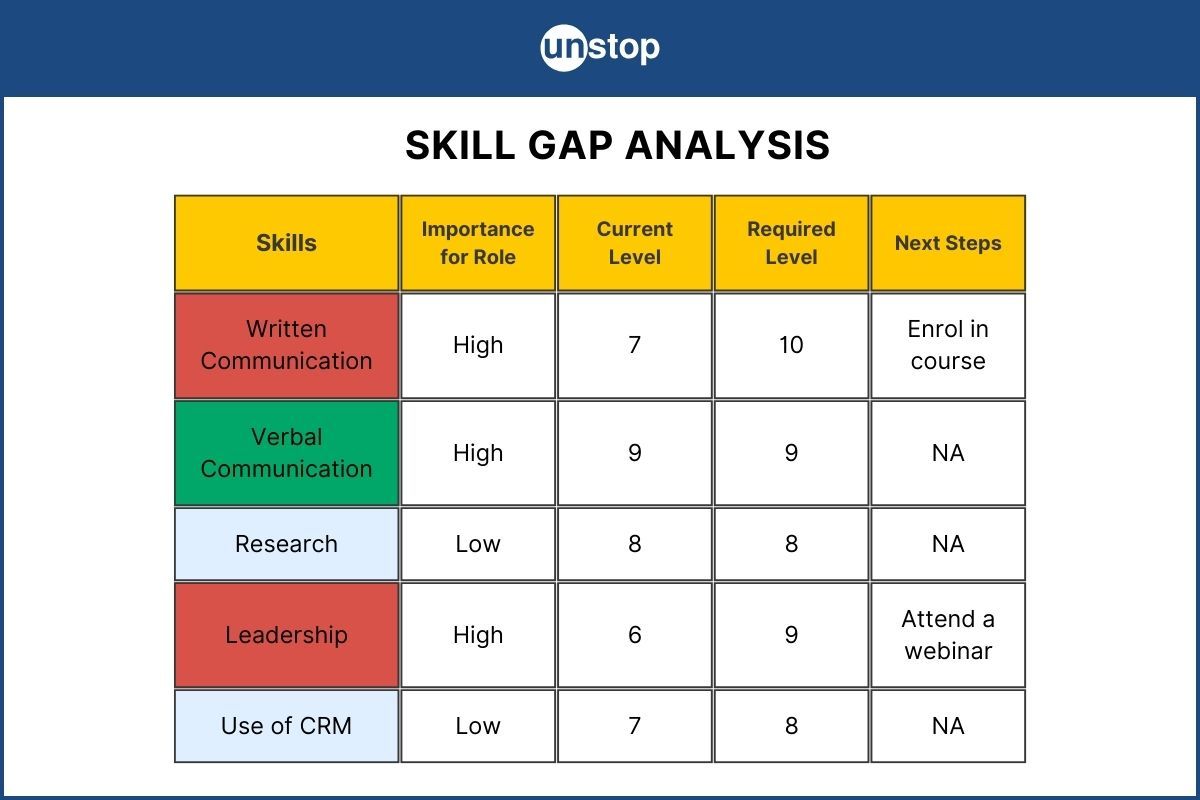
Skill gap analysis is the process of identifying the difference between the skills employees currently have and the skills they need for their jobs. This analysis helps employers determine training and development needs, as well as identify areas where additional hiring or outsourcing may be necessary.
Before we dive into the benefits of skill gap analysis and steps for conducting it, let’s first understand, what is a skill gap.
What’s a Skill Gap?
According to The Future of Jobs Report by the World Economic Forum, by 2025, employers expect that 44% of current employees will require reskilling due to technological advancements and changes in job roles. This highlights the need for continuous learning and upskilling to bridge the gap between existing skills and the skills required for future job roles.
A skill gap refers to the mismatch between the skills that employers require and the skills that employees possess. It occurs when there is a disparity between the skills and knowledge needed for a particular job and the qualifications and abilities of the available workforce.
For example, let's say a manufacturing company introduces new technology to automate certain processes. If the current employees lack the necessary technical skills to operate and maintain the new equipment, there is a skill gap. This gap can hinder productivity and innovation within the organization and may require the company to invest in training or seek external talent with the required skills. Organizations can conduct technical skill tests before hiring to ensure new hires have the requisite skills.
Skill gap analysis is the process that helps organizations identify the gap between current and required skill sets in the workforce. As PwC’s Global Workforce Hopes and Fears Survey 2023 puts it, “Employees can be forgiven for not having a clear view of their future skills requirements. Employers can’t.”
Effective workforce planning and development rely on employee skill gap analysis as it enables organizations to align their talent pool with business objectives. By pinpointing specific areas where employees lack the necessary skills, organizations can design targeted training programs to bridge these gaps.
When to Conduct a Skill Gap Analysis?
There's no set time to conduct an employee gap analysis because it depends on the nature of the business and the overall objectives. However, a yearly evaluation is commonly recommended by HR professionals or before new positions or employees are hired.
Employee Skill Gap Analysis: Why Do We Need It?
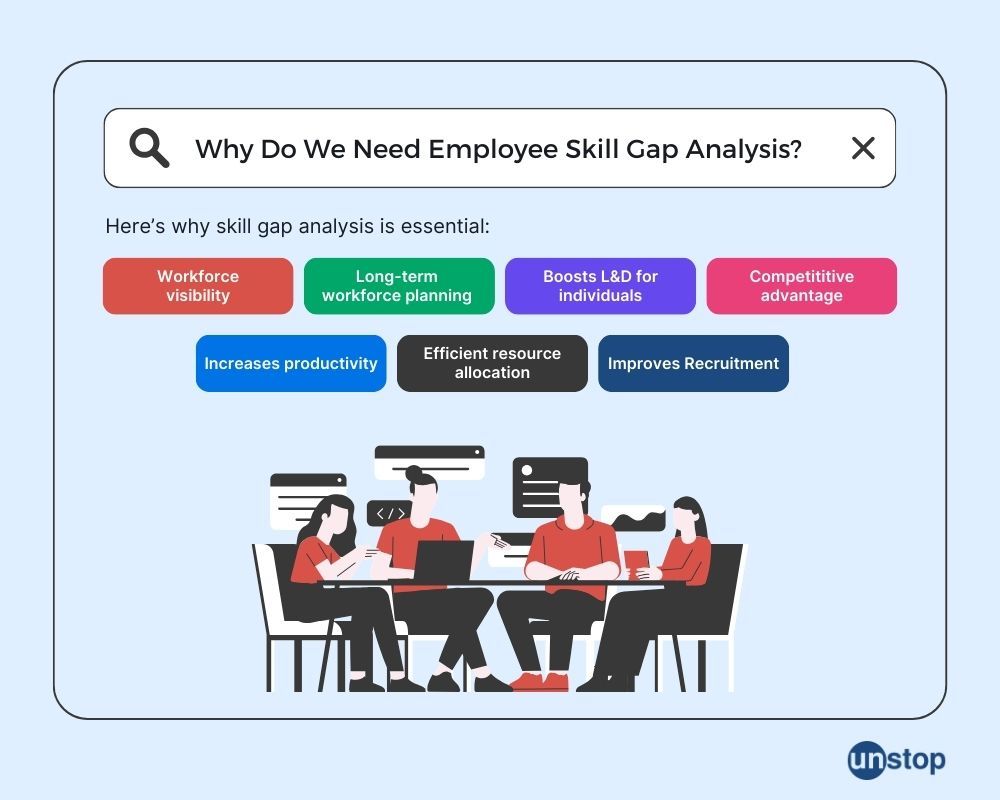
Skill gap analysis is an essential tool for organizations seeking to optimize their workforce's capabilities. Here’s why:
Gives full workforce visibility: Conducting an employee skill gap analysis allows organizations to gain an insight into the skillset of the entire workforce, from departments to individuals in a team. It also allows employers to identify people with desired skills and those with the most significant skill gap.
Enables long-term workforce planning: Workforce planning is understanding whether you’ve got the right number of people with the right skills in the right place. By identifying the skill gaps within the workforce, organizations can strategically plan for the future. They can determine what skills will be needed in the long run and develop strategies to bridge those gaps through hiring, training, or upskilling existing employees.
Boosts learning & development for individuals: An employee skill gap analysis also helps employees identify their skill gaps and areas for improvement. This analysis can be used as a basis for creating personalized learning and development plans, allowing individuals to excel in their roles, advance in their careers, and negotiate better raises and promotions by acquiring requisite skills.
Increases productivity: When employees have the right skills for their roles, they are more likely to perform their tasks efficiently and effectively. Conducting a skill gap analysis helps ensure that employees have the necessary knowledge and abilities to carry out their responsibilities, resulting in increased productivity and improved overall performance.
Creates a competitive advantage: A thorough understanding of the skills and capabilities of the workforce gives organizations a competitive edge. By identifying and addressing skill gaps, organizations can stay ahead of industry trends, adapt to changing needs, and deliver high-quality products or services. This enables them to differentiate themselves from competitors and attract top talent.
Efficient Resource Allocation: Organizations can allocate resources like training budgets, time, and personnel to address gaps in skills by identifying areas where certain skills are lacking. This ensures that organizations are not expending resources on areas with little to no returns, rather optimizing resources for maximum output.
Improves hiring planning and decision: It’s only when talent acquisition teams are aware of what skills are lacking in the workforce that they can hire effectively and improve the workforce. Skill gaps analysis allows HR professionals to tailor job descriptions and highlight the desired skills and competencies needed for specific roles. They can even design interview questions that focus on the identified skill gaps. This approach enables organizations to make informed hiring decisions.
As Kushendra Singh, Head TA, Coca-Cola stated in a podcast with Ankit Aggarwal, CEO, Unstop,
“If I’m hiring (from) the similar set of experiences, then that new hire isn’t adding anything to the team. Because everyone has the same set of thinking.”
Thus, by utilizing employee skill gap analysis, companies can bridge skill gaps, enhance overall employee performance, and boost business productivity.
How To Conduct Employee Skill Gap Analysis?
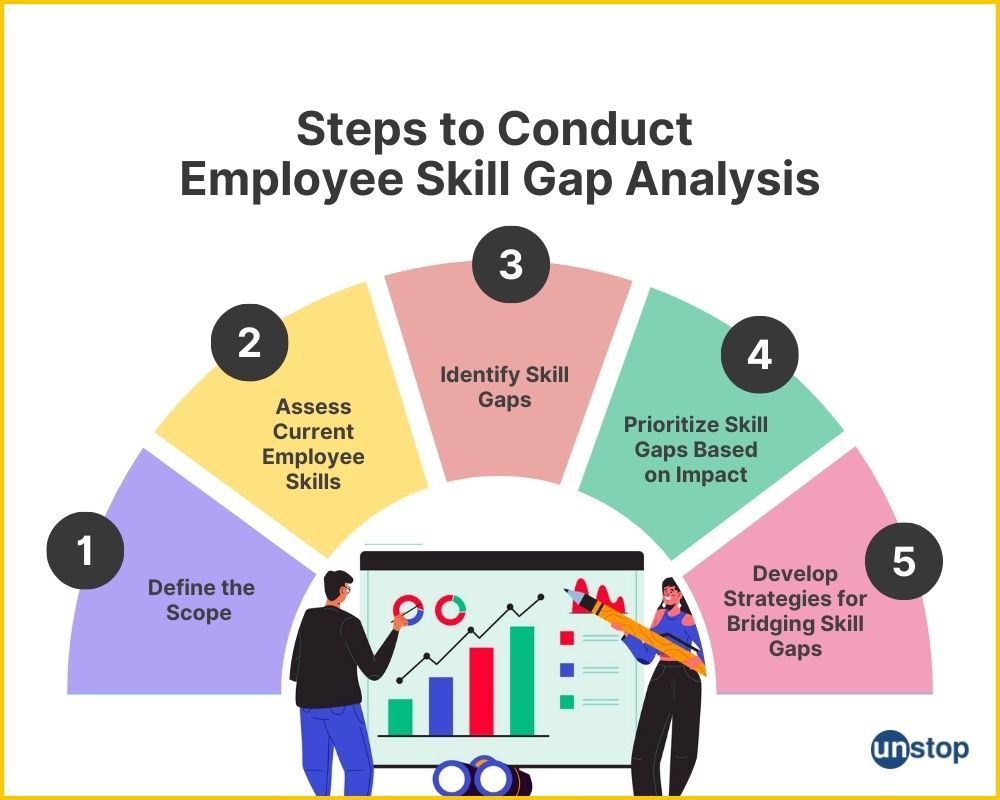
Here’s a step-by-step guide to conducting an employee skill gap analysis:
Step 1: Define the Scope
To conduct an effective skill gap analysis, it is crucial to start by clearly defining the desired skills and competencies for each job role within the organization. This involves identifying the specific knowledge, abilities, and behaviors that employees should possess to excel in their respective positions.
Simultaneously, organizations need to define the skills required for the future - this includes determining what skill set will help individuals, teams and the organization, as a whole, expand and grow.
Step 2: Assess Current Employee Skills
After defining the scope, it's time to assess employees and track their current skill levels. This can be done through surveys, interviews, tests or performance evaluations. By gathering information about their existing capabilities, organizations can gain insights into areas where employees may be lacking or where additional training may be required.
This step can be conducted at an individual level, team level, or even for the organization as a whole by finding answers to the following questions
-
Individual – If an employee is unable to meet the current job demands, or if the employee is unfit to meet the changing requirements of a role.
-
Team – If a team is equipped to work on a new set of deliverables, work with new technology, etc.
-
Organizational – If the overall business objectives are changing, or if the organization is consistently failing to meet set objectives and goals.
Organizations can opt for a wide variety of assessment tests to understand the degree and type of skill gap in employees.
Step 3: Identify Skill Gaps
After assessing employee skills, it's time to compare them with the desired skills identified earlier. This comparison allows organizations to identify any gaps that exist between what employees currently possess and what is needed for optimal job performance. These skill gaps highlight areas where further development or training is necessary.
Step 4: Prioritize Skill Gaps Based on Impact
Not all skill gaps are created equal. Some may have a more significant impact on business objectives than others. It is essential to prioritize these gaps based on their relevance and potential impact on organizational success. By focusing on addressing high-priority skill gaps first, organizations can allocate resources effectively and maximize their efforts towards achieving desired outcomes.
Step 5: Develop Strategies for Bridging Skill Gaps
Once skill gaps have been identified and prioritized, the next step is to develop strategies for bridging those gaps. This may involve various approaches such as training programs, workshops, mentoring initiatives, or even hiring new talent with the required skills. Organizations need to consider what methods will be most effective in closing the identified gaps while aligning with their overall business goals
By following these steps, organizations can conduct an effective skill gap analysis that provides valuable insights into areas of improvement within their workforce. Identifying and addressing skill gaps not only enhances individual employee performance but also contributes to the overall growth and success of the organization.
Sample Skill Gap Analysis:
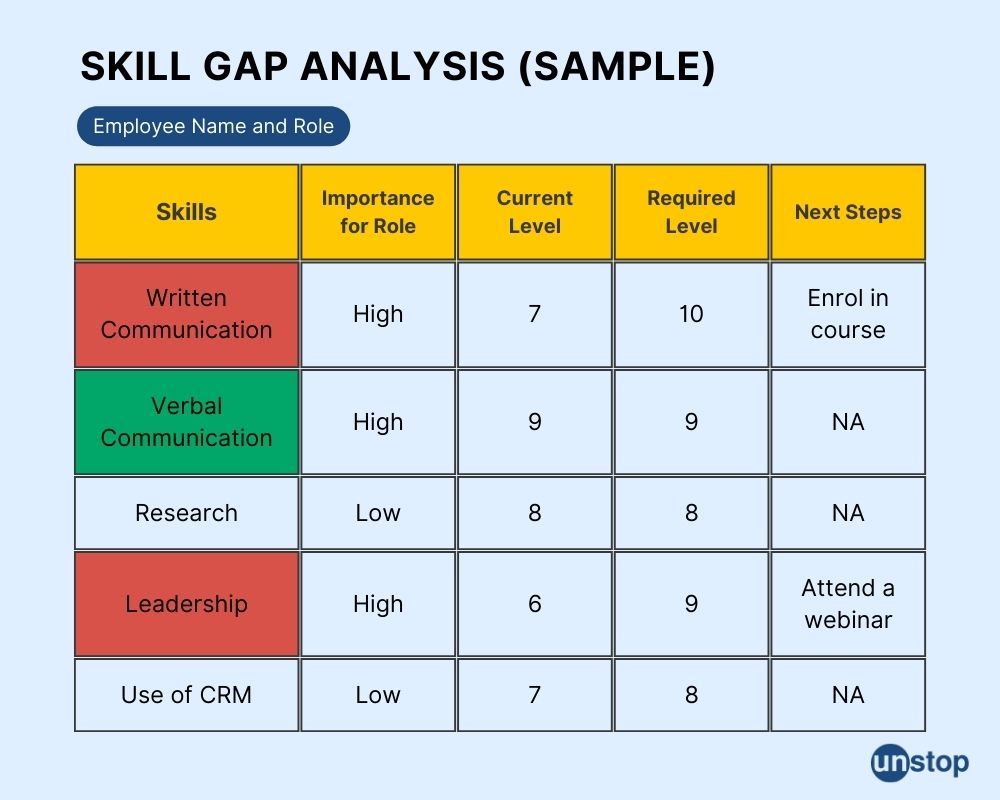
Addressing Skill Gaps Through Training and Hiring
Organizations can adopt various approaches to bridge the skill gaps identified through an employee skill gap analysis.
Take for example a team where content writers need to develop SEO expertise:
Targeted Training Programs
Targeted training programs can be designed to address the identified training needs based on the skill gap analysis.
Example: If content writers need to develop SEO content writing expertise, organizations can offer training sessions focused on SEO optimization techniques and best practices. By providing employees with the necessary knowledge and skills through additional training opportunities, they can become more proficient in their roles.
Workshops, Courses, or Mentoring Opportunities
Organizations can also provide workshops, courses, or mentoring opportunities to further develop employees' skills.
Example: Content writers can benefit from attending workshops conducted by industry experts that delve into advanced SEO strategies and techniques. Furthermore, pairing new team members with experienced mentors who possess strong SEO backgrounds can accelerate their learning process and help them acquire the necessary skills quickly.
Consider Hiring Individuals with Strong SEO Backgrounds
To fill skill gaps quickly and effectively, human resources departments can also consider hiring individuals who already possess a strong background in SEO. These candidates bring valuable expertise that can complement existing teams and contribute to closing the skill gaps identified in the analysis.
When incorporating new hires into the workforce, organizations should ensure a thorough hiring process that evaluates candidates' specific job-related skills and experiences related to SEO content writing.
Encourage Continuous Learning and Professional Development
To maintain a skilled workforce over time, organizations need to encourage continuous learning and professional development (L&D). It is also essential that employers create an atmosphere that fosters a culture of learning, where employees feel encouraged to investigate new ideas and experiments, and continuously improve their skills.
Example: In the case of content writers, regular L&D includes providing access to relevant resources such as online courses or subscriptions to industry publications.
These strategies not only enhance the capabilities of existing employees but also contribute to attracting and retaining top talent in the field. With a skilled and competent workforce, companies can stay competitive in today's digital landscape.
Utilizing Skills Gap Analysis for Strategic Planning
Skill gap analysis can also be incorporated into long-term strategic planning. By aligning business goals with the skills needed to achieve them, companies can ensure they have the right talent to drive success.
Align Organizational Goals with Skills
By identifying the specific skills needed to achieve business objectives, companies can develop a targeted plan for acquiring or developing those skills within their workforce. This alignment ensures that employees are equipped with the right capabilities to contribute effectively towards achieving overall business goals. For example, when hiring for customer-facing roles, organizations can conduct communication skills tests to ensure that candidates have the requisite skill set.
Adapt Training Programs
As industries evolve and new technologies emerge, certain skills may become more critical for success. By regularly assessing skill gaps, businesses can stay ahead of these changes and provide relevant training opportunities for employees. This proactive approach ensures that the workforce remains up-to-date and capable of meeting evolving job demands.
Anticipate Future Skill Gaps
By analyzing industry trends, market shifts, and technological advancements, organizations can predict which skills will be in high demand in the future. Armed with this information, they can develop proactive strategies such as hiring plans or partnerships with educational institutions to bridge these anticipated gaps before they become a hindrance.
By leveraging data-driven insights from a comprehensive skill gap analysis, businesses can make informed decisions regarding their talent management strategies. They can identify areas where additional training or recruitment efforts are required and allocate resources accordingly. This approach helps businesses maintain a competitive edge by ensuring they have a skilled workforce capable of meeting current and future challenges.
Leveraging Employee Skill Gap Analysis: Things To Keep In Mind
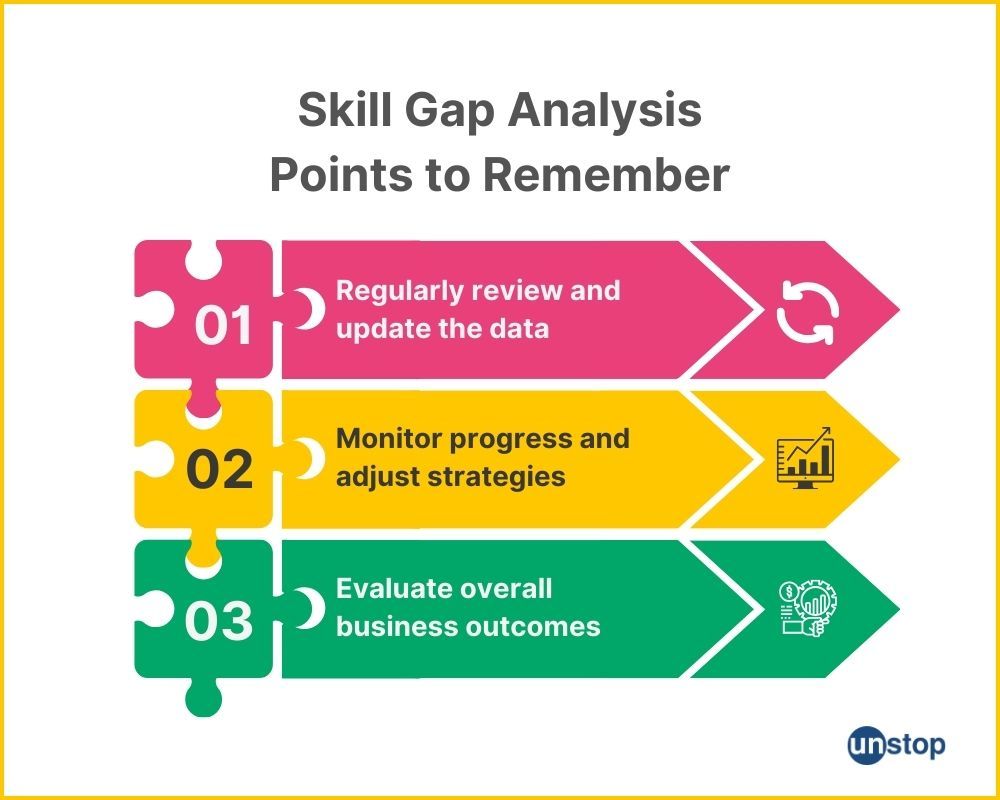
Regularly Review and Update Skill Gap Analysis Data
To ensure accuracy, it is essential to regularly review and update the data obtained from skill gap analysis. This involves revisiting the assessments, feedback, observations, and other sources of information used to identify the gaps in employee skills. By doing so, organizations can stay up-to-date with the evolving needs of their job roles and make informed decisions regarding training and development initiatives.
Monitor Progress and Adjust Strategies
Once training initiatives are implemented, organizations should closely track employee performance over time to determine if there has been any improvement in their actual skills. By comparing current performance levels with baseline measurements taken during the initial assessment phase, businesses can gauge whether their strategies are effective or need adjustment.
Remember to gauge the impact: Look beyond just completion rates or attendance records when evaluating training programs' effectiveness. Instead, assess whether employees have acquired new skills or improved existing ones through post-training assessments or evaluations.
Evaluate Business Outcomes
It's equally important to evaluate business outcomes as a whole. Companies should examine how reducing skill gaps impacts key metrics such as productivity, customer satisfaction, revenue growth, or cost savings. This evaluation will help determine whether investments in training and development initiatives are translating into tangible benefits for the organization.
By following these practices, organizations can effectively evaluate and act on skill gap analysis data.
In conclusion, conducting a thorough employee skill gap analysis is crucial for businesses to identify areas of improvement and develop targeted training programs. By addressing skill gaps, companies can enhance employee performance, increase productivity, and ultimately achieve better business outcomes.
Frequently Asked Questions
1. What is skill gap analysis?
Skill gap analysis is a process of identifying the differences between the skills an organization currently possesses and the skills it needs to achieve its goals. It helps identify areas where employees lack the necessary skills, enabling organizations to develop strategies for bridging those gaps.
2. Why is skill gap analysis important?
Skill gap analysis is important because it allows organizations to understand their current workforce's capabilities and determine what skills are needed for future success. By identifying skill gaps, organizations can implement targeted training programs, hire individuals with specific skills, or develop strategies to address these gaps effectively.
3. How do you conduct an effective skill gap analysis?
To conduct an effective skill gap analysis, follow these steps:
- Define the scope i.e. identify desired skills.
- Assess existing employee skills.
- Analyze the gaps between desired and existing skills.
- Prioritize areas that require immediate attention.
- Develop a plan to address the identified gaps through training or hiring initiatives.
4. How can skill gap analysis be used for strategic planning?
Skill gap analysis provides valuable insights into an organization's current and future workforce needs. By understanding the gaps in employee skills, organizations can align their strategic plans with targeted training programs or recruitment efforts to bridge those gaps effectively and ensure they have the right talent in place to achieve their long-term objectives.
5. How can skill gap insights enhance recruitment processes?
Skill gap insights can enhance recruitment strategies and processes by providing recruiters with a clear understanding of the specific skills required for each position within the organization. This information enables recruiters to target candidates who possess the necessary skills and proactively address any potential skill gaps during the hiring process, ensuring a better fit between candidates' abilities and job requirements.
Suggested Reads:
I’m a reader first and a writer second, constantly diving into the world of content. If I’m not writing or reading, I like watching movies and dreaming of a life by the beach.
Login to continue reading
And access exclusive content, personalized recommendations, and career-boosting opportunities.
Subscribe
to our newsletter
Blogs you need to hog!
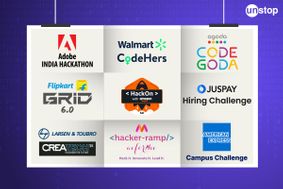
Organize Hackathons: The Ultimate Playbook With Past Case Studies

What is Campus Recruitment? How To Tap The Untapped Talent?
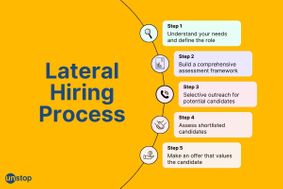
Lateral Hiring: A Complete Guide To The Process, Its Benefits, Challenges & Best Practices
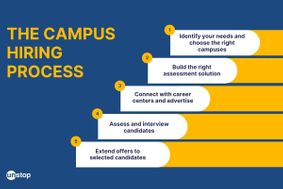












Comments
Add comment